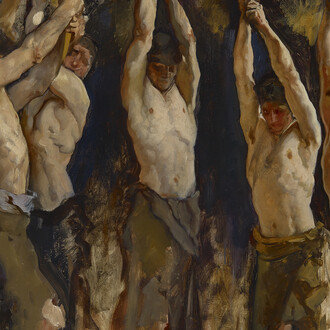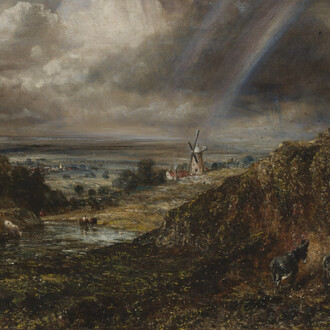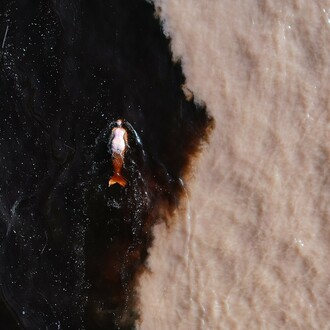For the last two decades Charles Avery has devoted himself to The islanders, an epic project that describes the inhabitants, topography, and culture of an imaginary island, through drawings, writings, objects and sculptural installations. Over the years this ever-shifting, non-linear narrative has grown to have such a specific and textured character that it is hard to believe the place doesn’t actually exist.
But it doesn’t, and in this new exhibition Avery reminds us of that, by putting the island aside and allowing his imagination to embrace an apparently new project titled The eidolorama – in which, as the critic and curator Tom Morton has noted, "the sprawling complexity that characterises The islanders is replaced by a radical economy of means."
In a sense, Avery has parked the philosophical intricacies of the island in favour of a simpler proposition that allows him to explore the pleasure of making paintings for their own sake, free from the potentially inhibiting presence of his own storyline. And yet, of course, given that this is Avery we are talking about, nothing is quite as simple as this perhaps slightly reductive explanation would suggest.
Let’s start with the title - The eidolorama takes its name from the idea of eidolons – a word derived from the spirits, idols and apparitions of ancient Greek literature, so beloved of the American poet Walt Whitman who defined them, in his poem of the same name, as: “Beyond thy lectures learn'd professor, / Beyond thy telescope or spectroscope observer keen, beyond all mathematics, / Beyond the doctor's surgery, anatomy, beyond the chemist with his chemistry, / The entities of entities, eidolons. / Unfix'd yet fix'd…”.
In Avery’s new realm, the Unfix’d yet fix’d entities of entities appear as a procession of forms, figures, and occasionally anthropomorphic shapes which belong to a kind of otherworldly community – each element paradoxically distinct from the next, and yet completely interconnected, and seemingly born to live in each other’s company.
In the old world of Avery’s island, the protagonist of the story The hunter (who famously acts as both artist and viewer) initially infers the existence of the island from a meditation on the horizon – something manifestly visible yet wholly intangible. He concludes that it must in fact exist and have substance. As Avery has noted, “you could broaden the definition of the horizon to mean the difference between things.”
In The eidolorama it is as if the island’s horizon has been breached and we find ourselves in a place beyond, tipped into another world with extra-dimensional possibilities. By his own account Avery is exploring the form and content of these shapes for their own sake, guided by a set of mathematical principles and revelling in the painterly possibilities of edge and surface. They present, he says, "a community of simple pictorial forms that comply and respond to the quadrilinear order of the rectangles that contain them… within this new matrix, one picture - or proposition - gives rise to the next - a primitive universe of simple and numerable parts… And while the paintings present as closed systems of purely abstract shapes, they also suggest worldly associations to apparently recognisable forms, such as keyholes, pills, planets, cells and sausages."
These worldly associations (albeit in an otherworldly context) might trigger thoughts of everyday experience, but they also nudge the seasoned Avery viewer back towards The islanders. One of the key paintings here A world of eight things or alimentari recalls an image that first appeared as a poster on a wall of the island’s city, Onomatopoeia. Equally, as the alternative title Alimentari playfully suggests, the image would make an excellent sign for a grocer’s shop. And of course, there are the island’s famous eels – lifeblood of the fictional economy, once described by Avery as ‘lines with faces’ and brought to mind in The eidolorama by the painting titled Three hundreds in which three squiggling lines, each a hundred times longer than they are wide, make their way across the canvas. As Avery puts it, “the substance of line, this accentuation and emphasis of the difference between things, is a key theme of The eidolorama, most notably in Three hundreds whereby the horizon (three of them in this case) become the thing rather than the difference. The embodiment of an abstract concept."
In a sense everything here is strangely familiar, as well as apparently new. Each painting has its own singular presence, unattached to any narrative or storyline and being entirely and uniquely discrete. As such The eidolorama sits in direct contrast to The islanders, or as Avery puts it, “The Islanders was an insight into another world, these pictures are the world. They are gallery creatures.”














